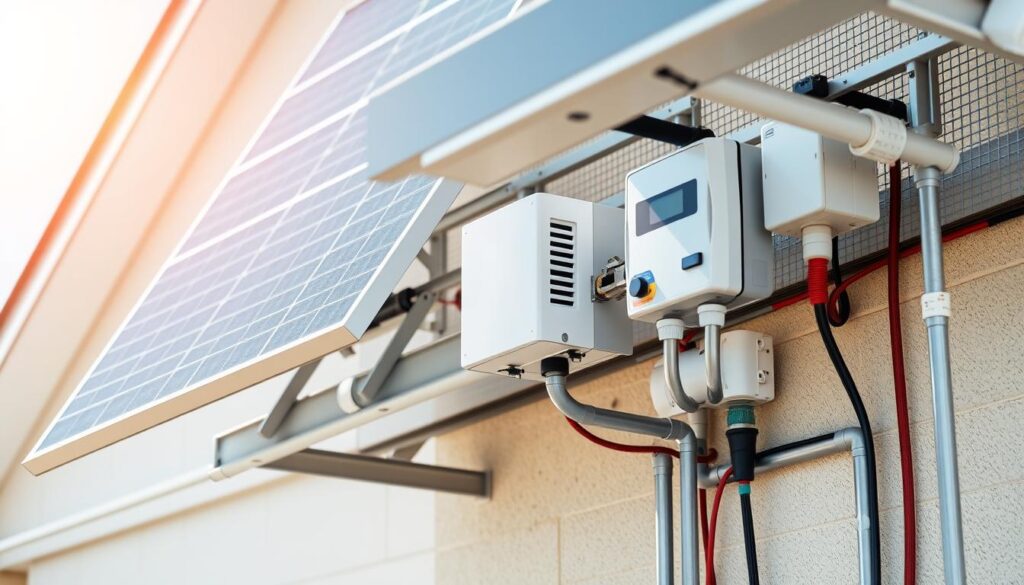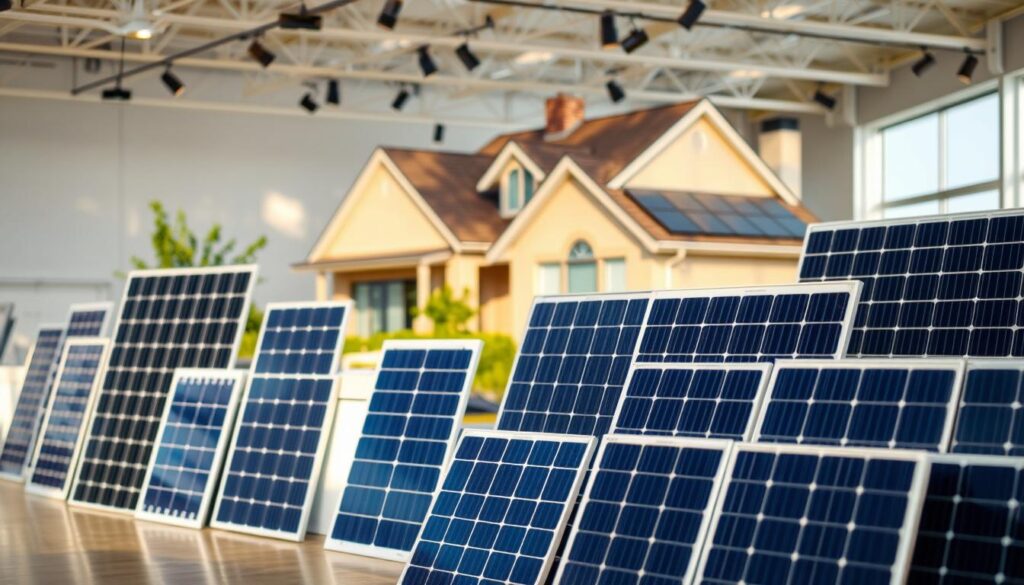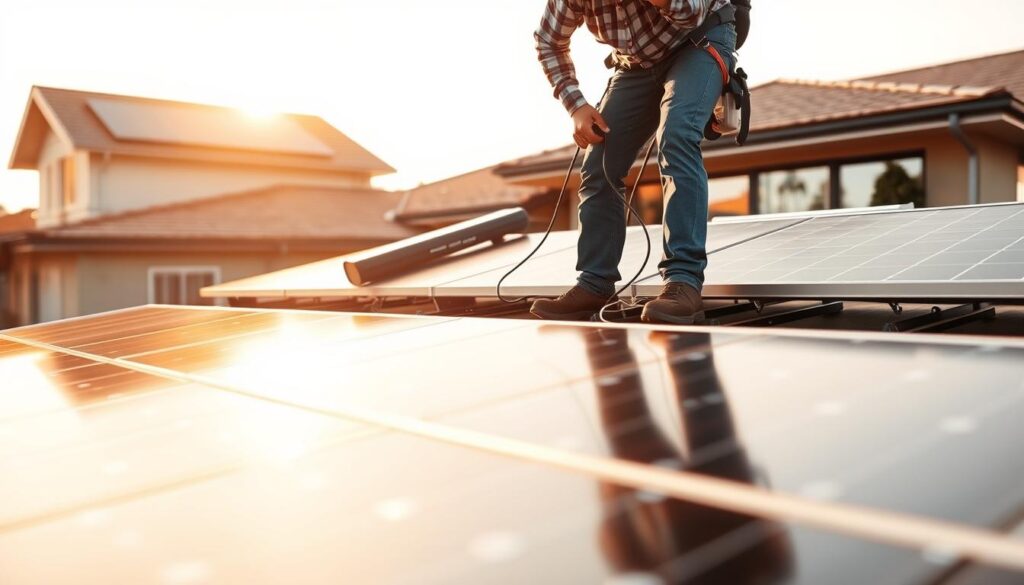Welcome to the world of home solar panel installation! Since 2008, solar energy has grown across the U.S., with hundreds of thousands of residential solar panel installations powered by innovations from the U.S. Department of Energy’s Solar Energy Technologies Office (SETO). This guide explores how solar systems work, costs, and the benefits of making the switch to clean energy.
Key Takeaways
- DIY solar panel kits save homeowners up to $10,500 versus professional turn-key installations.
- Solar equipment costs average $1.75 per watt, with 6 kW systems starting at $10,500 in equipment alone.
- Permits from local AHJ, HOAs, and utilities can take weeks to secure before installation begins.
- Solar-powered homes sell for 3.74% more, adding $14,329 in value compared to non-solar homes.
- Most solar panels maintain 80% efficiency for 25 years, with 75% exceeding warranty performance.
The Benefits of Solar Energy for Your Home
Making the switch to solar energy starts with home solar panel installation, a choice that rewards homeowners with long-term savings and environmental benefits. Whether you’re aiming to cut bills or reduce your carbon footprint, these systems deliver measurable advantages tailored to modern lifestyles.
“Homes with solar panels see a 4% increase in property value, similar to major home renovations.” — Berkeley National Laboratory Study
With affordable solar panel installation options and incentives like the 30% federal tax credit, homeowners can slash energy bills by up to 50%. Over 80% of solar users report satisfaction with savings, and systems often pay for themselves in 5–7 years. Programs like California’s DAC-SASH even offer free systems for eligible low-income families.
| Benefit | Key Statistic | Impact |
|---|---|---|
| Financial | 30% federal tax credit | Reduces upfront costs by thousands |
| Environmental | 4 million U.S. homes use solar | Cuts CO2 emissions by 3 tons/year |
| Independence | 25+ year panel lifespan | Steady energy supply for decades |
Every home solar panel installation reduces reliance on fossil fuels, protecting air and water quality. Residential solar systems eliminate 3 tons of CO2 annually—equivalent to planting 65 trees yearly. This collective effort helps meet national climate goals while improving local ecosystems.
Solar-plus-storage systems offer uninterrupted power during outages, ensuring safety during storms or grid failures. With a 25-year lifespan, these systems provide reliable energy for decades, shielding households from rising utility rates.
Understanding How Residential Solar Panel Systems Work
Solar energy system installation starts with photovoltaic (PV) panels capturing sunlight. These panels use the photovoltaic effect, a process discovered in 1839, to turn light into electricity. When sunlight hits the panels, it excites electrons in the silicon cells, creating direct current (DC) electricity. Residential solar panel installation systems then convert this DC power into alternating current (AC) electricity using inverters, which homes use for lights, appliances, and electronics.

- PV panels: Capture sunlight and generate DC electricity
- Inverters: Convert DC to AC electricity
- Mounting hardware: Secure panels to roofs or ground mounts
- Monitoring systems: Track energy production and efficiency
Energy flows from panels to your home’s electrical panel, reducing reliance on grid power. Excess energy can feed back into the grid via net metering or store in batteries for later use. Even on cloudy days, modern panels use scattered sunlight, not just direct rays, to generate some power.
“Solar panels work by harnessing sunlight’s energy, not heat, so cold or cloudy weather doesn’t completely stop electricity production.”
Residential solar panel installation systems last 25–40 years, making them a long-term investment. Properly installed systems by professionals ensure optimal performance, whether in sunny Arizona or cloudier climates like Oregon. Understanding this process helps homeowners see how solar energy system installation fits into daily life, paving the way for energy independence and cost savings.
Is Your Home Suitable for Solar Panel Installation?
Before investing in rooftop solar panel installation, assess three key factors: roof condition, local climate, and local rules. Many homeowners qualify, but preparation ensures smoother installation.
Evaluating Your Roof’s Readiness
Your roof’s age and structure matter. A roof older than 15 years may need repairs before panels are added. South-facing roofs with 15-40 degree slopes capture the most sunlight. Shading from trees or chimneys? Use free online tools like Google Project Sunroof to check shadow impacts.
“A sturdy, unshaded roof facing south is ideal, but modern panels still work in less-than-perfect conditions,” says the National Renewable Energy Lab.
Climate and Sunlight Availability
Cloudy regions like the Northeast still benefit. High-efficiency panels from brands like SunPower convert indirect light into energy. Use local climate data to estimate energy output. Even in areas with 10+ cloudy days/month, systems can offset 30–50% of electricity use.
Check Local Rules and HOA Policies
Homeowners associations (HOAs) sometimes restrict solar installations. Check state “solar rights” laws—29 states now limit HOA overreach. Need permits? Solar power installation services like SunPower handle regulatory checks. Federal tax credits (30% until 2032) apply even with HOA approval.
Types of Solar Panels for Residential Use

Choosing the best solar panels for home depends on your budget, roof space, and energy goals. Three main types dominate the market: monocrystalline, polycrystalline, and thin-film panels. Each offers unique advantages for different households.
Monocrystalline vs. Polycrystalline Panels
- Monocrystalline panels, with their sleek black cells, lead in efficiency (17–22%) and power output (up to 400W per panel). Ideal for small roofs needing maximum energy.
- Polycrystalline panels have a blue hue and efficiency of 15–17%, costing 10–15% less than monocrystalline. They work well on larger roofs with budget constraints.
Thin-Film Solar Panels
These lightweight panels (11% efficiency) attach easily to curved surfaces or shaded areas. CdTe options are budget-friendly, while CIGS variants excel in low-light conditions. Their flexibility makes them a smart choice for unique roof designs.
The Best Solar Panels for Home Based on Efficiency Ratings
Top performers include LG NeON R (22.3% efficiency) and SunPower’s X-Series (22.8%). Higher efficiency reduces space needs, simplifying solar energy system installation. Monocrystalline panels often top efficiency rankings, but thin-film shines in cost-sensitive setups.
When comparing, consider long-term savings. Monocrystalline panels degrade just 0.5–0.8% annually, ensuring reliable output over 25+ years. Thin-film’s lower efficiency may require more panels, affecting installation planning.
Home Solar Panel Installation: Step-by-Step Process
Transforming sunlight into energy starts with a clear plan. Whether you’re preparing for home solar panel installation or hiring solar power installation services, understanding each phase ensures a smooth transition to renewable energy.

Begin with a site evaluation to assess roof condition, shading, and utility access. Permits require coordination with local authorities and utility companies. Most jurisdictions need building and interconnection permits. Licensed installers handle paperwork, but homeowners must verify property ownership documents and clear access to electrical panels.
| Component | Purpose |
|---|---|
| Solar panels | Energy conversion |
| Inverters | AC/DC power conversion |
| Racking systems | Secure panel mounting |
| Electrical wiring (MC4 connectors) | Secure panel connections |
Professional crews use safety gear like harnesses, gloves, and goggles. NEC-compliant conduit (EMT) protects wiring, while grounding kits ensure system safety. Utility meters and safety disconnects are critical for grid compatibility.
- Permitting: 2–8 weeks (varies by location)
- On-site work: 1–3 days (panel mounting, wiring, and inverter setup)
- Inspection and grid connection: 1–4 weeks (post-installation testing)
Most systems activate within 3–4 months from initial consultation. Delays may occur if permits stall or unexpected roof repairs are needed. Schedule around weather, as rain or high winds can pause outdoor work.
Cost Breakdown and Financing Options for Solar Energy Systems
Affordable solar panel installation starts with knowing your options. The average solar energy system installation costs around $31,558, but tax credits and loans make it easier to manage. A 7.2kW system might cost $30,240, but the 30% federal tax credit cuts that by $9,072.
- Loans: Terms up to 25 years with rates as low as 3% APR.
- Leases/PPAs: No upfront costs, monthly payments often beat utility bills.
- Cash purchases: Full ownership and maximum savings after tax credits.
In states like California, a 5kW system costs ~$17,356. Over 25 years, switching from $120/month electric bills saves over $43,200. Many programs let you pay less than renting panels.
The federal tax credit drops to 26% in 2033, so acting soon locks in bigger savings. Check state incentives via DSIRE for rebates in states like New York or Iowa.
Solar loans from Fannie Mae cover up to 97% of costs, while SRECs add extra income. With these tools, solar energy system installation becomes a smart long-term investment. Start by comparing quotes and incentives to find your best fit.
Finding and Evaluating Professional Solar Panel Installers
Choosing the right professional solar panel installers ensures your system operates efficiently and safely. Start by researching solar panel installation companies with proven experience and certifications. Look for NABCEP certification, which verifies expertise in solar energy systems.
- Certifications and Licensing: Require proof of NABCEP certification and a valid C-10 electrical contractor license. Verify they hold general liability insurance.
- Experience: Ask for portfolios of past projects. Companies like ARE Solar, with certified installers and engineers, often deliver higher-quality work.
- Warranty Details: Compare warranties—longer terms (like 25 years) signal confidence in their work.
Ask these critical questions during consultations:
- Do you provide in-person site visits before quoting?
- What’s your process for obtaining local permits?
- Are maintenance services included post-installation?
Check reviews on Google, Yelp, and the BBB. Consistent negative feedback flags potential issues. Compare 3–5 quotes to avoid overpayment—variances can save thousands.
Always request references and confirm licenses via state databases. A reliable installer will clarify financing options, including the 30% federal tax credit, and explain how local incentives apply.
Maintaining Your Rooftop Solar Panel Installation
Regular upkeep keeps your rooftop solar panel installation running smoothly for decades. Most systems require little hands-on care, but seasonal checks and monitoring ensure warranties stay valid and energy output stays strong.
Solar panels can withstand hail and hurricanes, with limited damage observed during Hurricane Florence in 2018.
Seasonal Maintenance Requirements
Clean panels 2–4 times yearly to remove dust, leaves, or snow. Avoid using hot water on cold panels—sudden temperature shifts can crack tempered glass. After heavy snowfall, gently brush snow off panels to prevent shading.
- Use a soft brush and mild soap for cleaning.
- Check for debris after storms or seasonal changes.
- Inspect roof mounts annually for corrosion or looseness.
Monitoring System Performance
Track energy output via smartphone apps to catch drops early. A 1% efficiency loss occurs for every degree above 77°F, so monitor performance during extreme heat. If output falls below expected levels, schedule a professional inspection.
When to Call for Professional Service
Contact professional solar panel installers if you notice:
- Significant energy production drops (more than 10%).
- Physical damage like cracks or discoloredation.
- Inverter errors or electrical issues.
Most warranties require routine checks to stay valid. Annual inspections cost $150–$300 and ensure system integrity. Professional installers handle repairs to avoid voiding guarantees.
Common Challenges and Solutions in Solar Power Installation
Going solar can come with hurdles, but most are manageable with the right expertise. Solar power installation services and solar panel installation companies often resolve these issues through tailored approaches. Here’s how professionals tackle common roadblocks:
“By 2035, solar could supply 40% of U.S. electricity, but challenges like shading and permits must be addressed first.” – National Renewable Energy Laboratory (NREL)
- Roof issues: Aging roofs may require repairs before panels are mounted. Reputable installers inspect structures first.
- Shading: Partial shade can cut output by 20-30%. Solutions include trimming trees or using microinverters to optimize performance.
- Permit delays: Local permits often take 2-4 weeks. Top solar panel installation companies handle paperwork to speed up approvals.
| Challenge | Solution |
|---|---|
| HOA restrictions | Consult legal teams to ensure compliance with community rules. |
| Inverter failures | Choose high-quality inverters with 10+ year warranties. |
| Cost overruns | Providers offer financing plans to spread expenses. |
Regular maintenance—like biannual inspections—prevents issues like PID (Potential Induced Degradation), which can reduce output by up to 50%. Partnering with certified solar power installation services ensures proper setup and long-term performance. Remember: 90% of installation problems stem from poor planning, not the technology itself. Always verify contractor licenses and reviews before signing contracts.
Conclusion: Embracing a Sustainable Future with Home Solar Power
Making the switch to residential solar panel installation isn’t just a smart choice—it’s a step toward a cleaner, more secure energy future. From slashing electricity bills by 50-75% to boosting property values by 4.1%, the benefits are clear. The federal tax credit alone can cut costs by 30%, and programs like California’s Solar Initiative or New York’s NY-Sun offer extra savings. Choosing the best solar panels for home ensures maximum efficiency, turning sunlight into power for decades.
Over time, these systems pay for themselves in 5-10 years, with panels lasting 25-30 years. Every home adopting solar reduces reliance on fossil fuels, cutting emissions and protecting public health. Studies show this shift could prevent $167 billion in environmental damages annually. Homeowners also gain energy independence, especially with battery storage and smart inverters optimizing power use.
Ready to start? Research local incentives like Massachusetts’ $1,000 tax credit, compare quotes from certified installers, and explore performance-based incentives. Solar improves homes’ resale value and attracts eco-conscious buyers. Small steps today—like contacting a professional or calculating savings online—lead to big rewards. Join thousands of U.S. households turning toward clean energy, proving sustainability and savings go hand in hand. The future of energy is in your hands.
